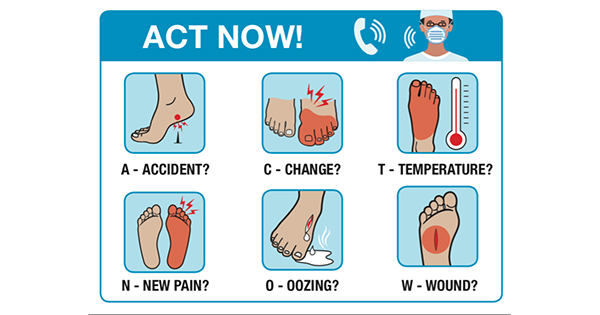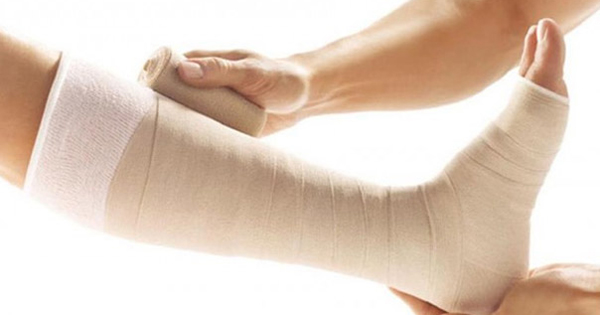The National Service Framework for Diabetes (Department of Health, 2002) has drawn up standards for the inpatient care of patients with diabetic foot disease. Strategies have been developed in an attempt to reduce the substantial co-morbidity and mortality related to this disease. Figure 1 shows a hospital inpatient receiving vacuum suction treatment for a foot ulcer. Detailed information systems are also being designed to help improve the quality of service delivery. The main aim of our survey was to try to determine the impact of foot complications on hospital bed occupancy, patient outcome and current specialist service resources.
Methods
Poole Hospital is a district general hospital serving a population of 250 000. The diabetic foot clinic is a multidisciplinary twice-weekly clinic with an average of 12 patients per clinic. The survey period was from November 1, 2000, to October 31, 2001, and included patients admitted electively from the foot clinic and those admitted to the hospital in whom foot complications or associated problems were the main reason for hospital admission or stay. Inclusion and exclusion criteria are shown in Figure 2.
Inpatient diabetes care is provided by the medical team, an orthopaedic specialist with an interest in the diabetic foot, a vascular surgeon, a podiatrist (for the weekly inpatient session), a DSN, dietitian and ward nurses.
Information on patient demographics, length of hospital stay and outcome at the time of discharge was recorded on an Excel spreadsheet.
Patient outcome was classified as:
- Conservative management with significant wound improvement (incorporating strict bed rest, intravenous antibiotics and inpatient podiatric assessment and treatment).
- Angioplasty or bypass procedure.
- Operative procedure:
a. Surgical debridement
b. Toe amputation
c. Forefoot amputation
d. Below knee amputation (BKA)
e. Above knee amputation (AKA) - Death.
Patients were discharged on the basis of good clinical evidence of wound healing, with the elimination of sepsis and necrotic tissue. Post-discharge care ensured adequate off-loading and domiciliary support with regular foot clinic attendance. Elderly or infirm patients may have also received temporary placement in rehabilitation centres with regular review in the diabetic foot clinic. Patients who had had major amputations were subsequently also reviewed in the limb fitting centre.
Results
In total, 29 patients met the inclusion criteria and were admitted over the study period; there were 32 admissions (three re-admissions). The mean patient age was 70.2 years (35–89 years) and 69% were male. There was a notable peak during the winter period in the pattern of admissions throughout the year (Figure 3).
Patients (n=29) were admitted with the following foot complications: 20 (70%) with infected foot ulceration, three (10%) with unresolving foot ulceration, three (10%) with severe complications of neuropathy, two (7%) with gangrene and one (3%) with severe lymphoedema.
A total of 14 patients (48%) were managed conservatively and four patients (14%) required vascular intervention (angioplasty or bypass procedure) to enhance healing. Surgical wound debridement was performed on one patient (3%), and seven patients (24%) had amputations (three toe amputations, one forefoot amputation, one BKA and one AKA). Three patients (10%) with severe infected foot ulceration died from concomitant cardiovascular causes (Figure 4).
The average length of stay of patients with diabetic foot disease was 22.2 (range 3–56) days. Of patients admitted with infected foot ulceration that was managed conservatively (n=12), the average length of stay was 19.1 days compared with 29.8 days for those (n=9) who had an operative procedure (e.g. amputation) or vascular intervention.
Discussion
There is a substantial hospital bed occupancy for diabetes related to admission for diabetic foot complications. Foot complications tend to represent the main inpatient clinical workload for UK hospital diabetes teams (Waugh, 1998). Although we have not quantified patient bed occupancy as a proportion of total medical admissions, diabetic foot complications represent our main ‘specialist’ workload. The estimated total bed occupancy for one year is 711 patient bed days, and the observed pattern of increased admissions during the winter months tends to aggravate ‘bed pressures’ at the time.
Infected foot ulceration represents the main cause for hospital admission for diabetic foot complications (23 out of 32 admissions; 72%), and although we did not detail the exact source of referral, most cases were admitted from the diabetic foot clinic. Patients may also have been referred by medical or surgical (including orthopaedic) colleagues, and others were admitted under our care directly from the accident and emergency department. It is also likely that some patients with foot complications may have bypassed our care and would not have been included in this audit. The multispeciality involvement in diabetic foot complications may lead to exclusion of cases during the audit period. Our team is, however, generally renowned in the hospital for its interest in the diabetic foot, and ‘initial treatment guidelines for treatment and referral’ are present on all hospital wards and on the hospital intranet. We believe that such factors would help minimise bias on our reported patient outcomes.
We did not utilise a standard wound classification system (Jeffcoate et al, 1993), although management strategies for use of antibiotics and wound care were based on standard published protocols (Mason et al, 1999). ICD codes were not used because the inclusion and exclusion criteria are directly related to diabetic foot disease or complications associated with neuropathy. It would have been difficult, if not impossible, to define these complications accurately based on ICD codes alone.
Amputation rates
An overall amputation rate of 24% in admitted patients compares well with our own previous admission records for diabetic foot clinic amputation rates (23% in 1997, unpublished data) and with other published series (Apelqvist and Agardh, 1992). Further analysis showed that 36% (9/25) of patients admitted with infected foot ulceration or gangrene had an amputation (below ankle level in 55%). The overall major amputation (BKA or AKA) rate was 12.5% (4/32). A two-year retrospective audit in Gwent similarly showed an amputation prevalence rate of 7% (De et al, 2000).
Our estimated amputation rates may also be influenced by off-site location of the vascular services (Royal Bournemouth Hospital), and our analysis does not include patients who may have been referred directly to the surgical vascular teams. The estimated length of patients’ hospital stay did not include their stay on the vascular ward, although patients were generally transferred back to our care before home discharge.
Based on average hospital bed occupancy costs alone (£250 daily in Poole Hospital), the overall annual cost for admissions for patients with diabetic foot complications during our survey was £177 750. Projected costs for vascular or surgical intervention, amputation and rehabilitation are, however, not included and are likely to produce a hefty underestimate of the real figure! Krentz et al estimated an annual hospital cost of £400 000 in a prospective survey conducted in 1997 (Krentz et al, 1997). In the US, lower extremity amputations are estimated to cost about $25 000 per case (Reiber et al, 1992).
Conclusions
The National Service Framework for Diabetes (Department of Health, 2002) highlights that the core team should have ‘unhindered access to urgent inpatient facilities’. Generally increasing trends of ‘acute medical bed’ occupancy in NHS hospitals may hinder easy access to such patients. Besides, as shown in our survey, patients at diabetic foot clinics tend to have longer than average hospital stays as a result of the complication itself or commonly associated co-morbidities or social problems, further aggravating ‘bed pressures’. Proper implementation of these guidelines will require substantial investments related to ‘speciality bed’ availability and a regular inpatient podiatric service.
It is now time for service providers to invest adequately into this speciality as any projected costs to improve services would be trivial in comparison with the socioeconomic implications related to diabetic foot disease. As an example, we estimate that an inpatient specialist podiatric session (i.e. a four-hour session each week) would cost about £5000 per annum. We believe that an extra session in our hospital would reduce length of stay by at least 10%, an immediate saving of £17 000 per annum based on bed occupancy alone.
A questionnaire by Edmonds et al (2000) on behalf of the Diabetic Foot Forum has also shown the clear benefits of diabetic foot registers, namely that they allow the auditing of information and proper implementation of agreed guidelines. In conclusion, the overall financial costs, multiprofessional team service provisions and management strategies involved in the delivery of care to diabetic foot patients need to be urgently addressed to help us meet our targets.





